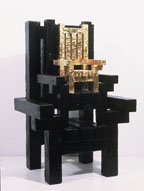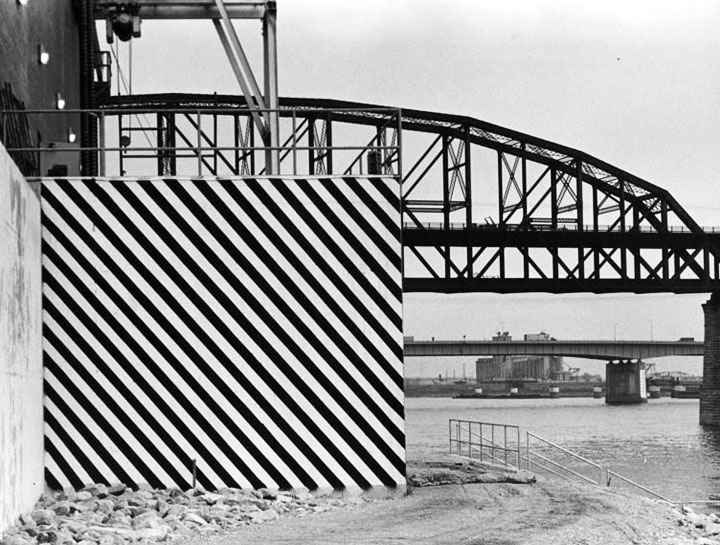|
Threads | The New Venture Series
Jim Nickel’s New Venture Series began in the spring of 2012 with Venture Pieces on a smaller scale. The New Venture Series draws from earlier work in several genres but with significant changes. The plywood of earlier work became solid slabs of hardwood. The black-and-white Venture language became more intricately realized, its complex geometry deriving more directly from cuts and reconfiguration of the wood.
Martin Heidegger
Nickel, a philosophy major, was transfixed by a passage from Martin Heidegger’s Introduction to Metaphysics, speaking of the creative person as being always “in venture.” It is the artist, Heidegger wrote, “who sets forth into the un-said, who breaks into the un-thought, compels the unhappened to happen and makes the unseen appear.” Venture became a persistent metaphor across decades of art making.
Visual imperatives
From the early days in St. Louis through decades in Brooklyn and now at his studio in Woodstock, N.Y., Nickel has explored the landscape with bicycle and camera. He has long been intrigued by the cautionary power of diagonal black and white slashes, by their ability to surmount even dense urban visual clutter, by their silent command of attention. They need no words — neither CAUTION nor CUIDADO — just simple, effective, aesthetically compelling black and white.

The Venture Stores
Venture Stores, an upscale discount chain within the May Department Stores group, was founded in 1968, shortly after Nickel had arrived in St. Louis. Its first store opened in suburban St. Louis in 1970, and by the mid-1970s there were 20 Venture stores in greater St. Louis. Nickel found them in an instant — or they found him — and visited them all with his Minolta and ten-speed. Venture Stores expanded into the Midwest — north to Chicago and south into Texas — and then into bankruptcy, its stores ingested by competing discount chains. By then, the black and white diagonals — the Venture Series — had become an enduring part of Nickel’s art.
The plywood pieces
The explorations began as two-dimensional
rearrangements of plywood sheets. Nickel plotted precise edge-to-edge lines according to a given mathematical sequence — the
Fibonacci sequence was a favorite — then cut the sheet with his power saw. By uniformly offsetting each piece or by reassembling pieces in a predetermined order, Nickel coaxed the flat rectangle into graceful arcs, multiple lobes, and complex shapes, losing only the sawdust.
(View all the plywood pieces.)

The plank progressions
Beyond plywood, Nickel applied the same arithmetic approach and conceptual restrictions — losing only the sawdust — to wooden planks. Many of them were found scrap, difficult materials whose exteriors Nickel honored by leaving them in a rough state. One critic described the act of probing interiors with a saw as searching for and connecting hidden planes — Heidegger’s notion of compelling “the unhappened to happen.” The reassembled planks ranged from massive
(Pineapple Club) to fragile and gangly (Spindle Piece). (View all the plank pieces.)

Incised Venture pieces
In St. Louis and later in New York City, Nickel brought the black-and-white Venture language to his plywood pieces. To bridge the two extremes of the attention-commanding visual binaries (black or white, one or zero, hot or cold) and to connect the Venture scheme with the less commanding reconfigured wood, Nickel incised long bands of lines across the entire work. The woven pattern of these intertwined bands added a sense of depth, a virtual third dimension reminiscent of his earlier large paintings. The plywood also began to take three-dimensional shape, curled with hot water and steam as with the
Curled Venture Piece. The known and the unknown
More than three decades after the initial Venture encounter in St. Louis, Nickel’s New Venture Series “compels the unhappened to happen and makes the unseen appear.” His precisely planned cuts and controlled reassembly continue to transform the wood — now thick planks and slabs of maple, mahogany, walnut, beech, cherry. The pieces undulate and come forward from the wall. The black-and-white Venture language — now incorporating QR codes on occasion — achieves definition only when the wooden pieces come together, the final configuration of the Venture language neither planned nor known, yet not entirely random.
View all Venture Pieces
|










